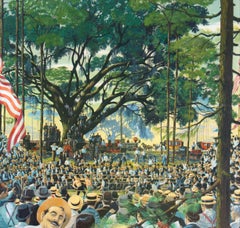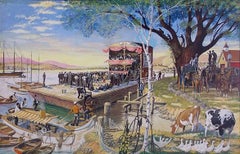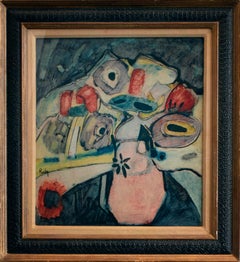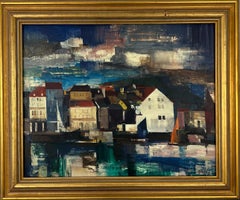J. Graham Kaye Art
to
2
Overall Width
to
Overall Height
to
2
2
2
1
1
1
1
1
1
1
1
2
1
1
1
1
2
10,083
2,772
1,380
1,375
2
2
Artist: J. Graham Kaye
"The Sullivan-Kilrain Fight" Story Illustration
By J. Graham Kaye
Located in Fort Washington, PA
Date: Undated
Medium: Oil on Masonite
Signature: Signed Lower Left
An undated story illustration depicting the 1889 bare-knuckle heavyweight title fight in Richburg, Mississippi, wh...
Category
20th Century J. Graham Kaye Art
Materials
Masonite, Oil
Crowd Watching the Fight
By J. Graham Kaye
Located in Fort Washington, PA
Medium: Gouache
Dimensions: 14.50" x 22.50"
Signature: Signed Lower Right
Category
20th Century J. Graham Kaye Art
Materials
Gouache
Related Items
Post Impressionist Portrait Painting with Antique Frame
By Donald Roy Purdy
Located in Washington, DC
Painting by Donald Purdy (1924 - 2016).
Oil on masonite
Measures 25"L x 23"W.
Work is behind glass and comes with exceptional antique frame.
Acquired from the Schoneman Gallery in NY...
Category
1960s Post-Impressionist J. Graham Kaye Art
Materials
Masonite, Oil
$1,800 Sale Price
20% Off
H 25 in W 23 in
Seashore Town- Mid-Century Modernist Gouache and Oil Painting
Located in Marco Island, FL
A dramatic painting of a seaside town done in bright colors. The abstract American scene style captures the moody sky, and the reflection of water captures the viewer's attention.
...
Category
Mid-20th Century J. Graham Kaye Art
Materials
Oil, Gouache, Board
$5,600 Sale Price
20% Off
H 21 in W 25 in D 2 in
Abstract Nature Painting on Canvas, Framed. Acrylic, Ink. Greens, Blues, Peach
By Alex K. Mason
Located in Versailles, KY
Abstract Nature Painting Alex K. Mason "Lush Green Spring". Acrylic, Ink on Canvas in white washed frame, 31.5"H x 25.5"W x 2.25"D, Greens, Blues, peach, orange, yellow, grey, whites...
Category
2010s Abstract Expressionist J. Graham Kaye Art
Materials
Canvas, Ink, Acrylic, Gouache
$3,525
H 31.5 in W 25.5 in D 2.25 in
"The Walk Back Home" A Monumental "Exhibition" Painting by Carl Lasch
Located in Queens, NY
Carl Lasch (1822-1888 German) "The Walk Back Home" A Monumental Exhibition Painting,
Oil on canvas laid to masonite in original gilt-wood frame.
...
Category
19th Century J. Graham Kaye Art
Materials
Masonite, Oil
$361,700
H 72 in W 85 in D 7 in
“Central Park in Winter, 1949” Manhattan New York City Snow Day Sleds Children
Located in Yardley, PA
With a studied hand, Sloan captures the human theater of a snow-covered Central Park filled with bundled-up New Yorkers, sledding, walking, chatting, and caring for children. The exp...
Category
1940s American Modern J. Graham Kaye Art
Materials
Tempera, Oil, Masonite
$5,500
H 29.75 in W 35.75 in D 2 in
The Breakfast Room
Located in New York, NY
A great early date for this artist where he was coming out of the origins of expressionist and fauve works of art. A unique composition depicting a woman setting out a table laden w...
Category
1960s Expressionist J. Graham Kaye Art
Materials
Masonite, Oil
Abstract Seated Figure
By Norbert Lenz
Located in Indianapolis, IN
Lenz was born in Norwalk, OH on March 2, 1900. A twentieth century American painter, illustrator and commercial artist, Lenz received his artistic education at the Huntington Polyte...
Category
20th Century Abstract Expressionist J. Graham Kaye Art
Materials
Masonite, Oil
"Haitian Island Scene with Fishermen" Large Nautical Folk Art Painting of Boats
Located in Austin, TX
Board Size: 24 x 30 in.
Frame Size: 31 x 37 in.
Signed, bottom Left: "F. Lamothe"
In this oil and wax on Masonite painting, Haitian artist Fritz ...
Category
Mid-20th Century Folk Art J. Graham Kaye Art
Materials
Masonite, Wax, Oil
Untitled: Abstract Figure and Leaves
By Gio Colucci
Located in Berlin, MD
Gio Colucci (Italian 1892-1974) Untitled: Abstract Figure and Leaves. Gouache on paper laid down on matt board. Archival framing under glass. Originally from the Con-Agra Corporat...
Category
Early 20th Century Abstract J. Graham Kaye Art
Materials
Gouache, Laid Paper
"Appi" Amaranth Ehrenhalt, Unique Painting, Woman Abstract Expressionism, 2003
By Amaranth Ehrenhalt
Located in New York, NY
Amaranth Ehrenhalt (1928–2021)
Appi 13, 2003
Gouache and watercolor on thick paper
Painting: 20 x 20 cm l 8 x 8 in.
Frame: 33 x 33 cm l 13 x 13 in.
Signed, titled and dated
Amarant...
Category
Early 2000s Abstract Expressionist J. Graham Kaye Art
Materials
Paper, Watercolor, Gouache
Leaving the Factory- American Scene Watercolor Painting-WPA Painter
Located in Marco Island, FL
David Fredenthal captures the chaotic rush of men leaving their jobs at the factory. The setting is possibly the Rouge Factory, one of Henry Ford's most important and earliest fact...
Category
Early 20th Century American Realist J. Graham Kaye Art
Materials
Gouache, Archival Paper
$42,000
H 33 in W 43 in D 2 in
Harbour Dwellings
Located in Norwich, GB
In his early years Colin Kent studied and worked as an architect. He was elected a member of the Royal Institute of Painters in Watercolours in 1971 and then became a full time paint...
Category
21st Century and Contemporary Contemporary J. Graham Kaye Art
Materials
India Ink, Acrylic, Watercolor, Gouache, Archival Paper
J. Graham Kaye art for sale on 1stDibs.
Find a wide variety of authentic J. Graham Kaye art available for sale on 1stDibs. You can also browse by medium to find art by J. Graham Kaye in paint, gouache, masonite and more. Not every interior allows for large J. Graham Kaye art, so small editions measuring 21 inches across are available. Customers who are interested in this artist might also find the work of Marguerite Blasingame, Leo Mancini-Hresko, and Rob Brooks. J. Graham Kaye art prices can differ depending upon medium, time period and other attributes. On 1stDibs, the price for these items starts at $5,500 and tops out at $7,500, while the average work can sell for $6,500.



